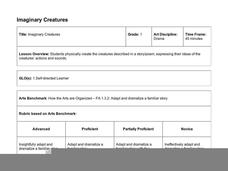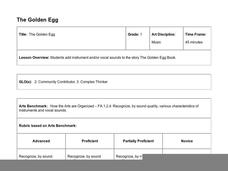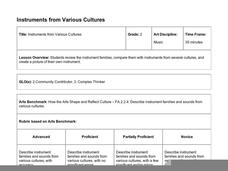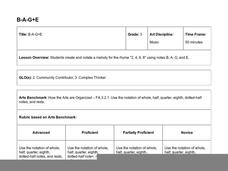Asian Art Museum
Japanese Architecture for Elementary School Students
Art and architecture go hand-in-hand. Kids watch clips from the Hayo Miyazaki film Spirited Away to better understand Japanese customs and architecture. The discussion questions included are very good, and will help you lead the class in...
Hawaiʻi State Department of Education
Push and Pull
I love mixing arts lessons with core content! Here, the class will discuss energy, motion, and force (push/pull) as they review dance vocabulary and movements. They preview vocabulary for force and dance. Then they pair-up to dance a...
Hawaiʻi State Department of Education
Imaginary Creatures
Drama and movement are wonderful ways to cover story elements such as setting, character, and descriptive writing. Little ones listen to a poem about imaginary creatures. As they listen, they shape their bodies into what they think the...
Hawaiʻi State Department of Education
The Golden Egg
Get ready for a musical story time! First your young musicians review musical dynamics as they listen to and discuss the pitch and sound of each instrument you play for them. Then they talk about special words (mostly verbs) in the book,...
Hawaiʻi State Department of Education
Instruments from Various Cultures
After a review of orchestral instruments and instrument families, learners make their own. They listen to the song "Simple Gifts" and identify the instruments heard in the piece. Then they draw an instrument of their own invention,...
Hawaiʻi State Department of Education
Cloud Sculpting
Dance is a fantastic way to communicate thoughts, feelings, and even science concepts. Make this activity a part of your next unit on weather and clouds. Kids will discuss types of clouds, how they look, and what they do. Then, they will...
Hawaiʻi State Department of Education
Mask Symmetry
When you engage learners in creating symmetrical objects you are also building their vocabulary and math sense. Kids discuss key words such as, asymmetrical, symmetrical, balance, tint, and shade. They use these elements of design to...
Curated OER
Moby Dick Puppetry
Such an ambitious lesson! Third graders with special needs listen to an audio recording of the novel, Moby Dick. They stop often to discuss each of the main characters and analyze their actions in the story. They then make puppets of one...
Hawaiʻi State Department of Education
Sequence of Events
Are you in need of a new way to teach learners sequence of events and how to interpret a character's external motivations? Why not engage them in dramatic play? The class will use tableaux to convey the sequence of events in a familiar...
Hawaiʻi State Department of Education
Story Design
Stories contain very specific elements; plot, characters, and key events. Learners use pantomime to retell a key event from the beginning, middle, and end of a story. They discuss setting and character as each group discusses and then...
Hawaiʻi State Department of Education
Picture Poetry
What a fun idea! The class discusses, and then writes free-verse poems using sensory detail. They get into small collaborative writing teams to compose their poems. Next, they pantomime the actions from the poem while their teammates...
Hawaiʻi State Department of Education
Finding the Main Idea
You can mix almost any subject with an arts curriculum. Find out how to use drama to find the main idea of a literary text. You'll read a story, and then learners will make tableaus showing what happened, or what they think will happen...
Hawaiʻi State Department of Education
Pilobolus
After reviewing dance-specific terminology and watching a clip from the dance troupe Pilobolus, learners create dances of their own. They pair up and use the teacher's cues to create creature dances that exemplify mood and shape. Any...
Hawaiʻi State Department of Education
What’s My Vocabulary Word?
The elements of dance can be used to communicate thoughts and, in this case, words. In small groups, the class first creates a set of movements to show a single word. Then, they extend their movements to show a three-word phrase....
Hawaiʻi State Department of Education
B-A-G+E
Budding musicians discuss rhythmic notation and melody as they play a bar instrument or recorder. They use the notes B, A, G, and E to play a simple melody, and then they use those same four notes to turn a poem into a song. They play...
Hawaiʻi State Department of Education
Crow Boy
There is a difference between actions, motives, and the appearance of a character in a narrative text. Fourth graders explore character analysis through the dramatic arts. They create a series of movements, tableaus, and pantomimes to...
Hawaiʻi State Department of Education
Gargoyles Galore
Grrrrr, gargoyles are on the loose! Young artists are familiarized with the history of gargoyles, examine pictures of them, and hear a story about them. Then, they draw a gargoyle and write down exactly how they did it (procedural...
Hawaiʻi State Department of Education
Rhythm Patterns
Fractions can be tricky. Why not have kids think of fractions like they think of eighth, quarter, and half notes? In teams, the class creates four-measure patterns with their percussion instruments. They need to explain their rhythm...
Hawaiʻi State Department of Education
Angles on Kandinsky
Not only is Wassily Kandinsky fun to say, his art contains tons of angles. Learners discuss Kandinsky's music-inspired abstract art and four types of angles. They search one of his paintings for obtuse, right, straight, and acute angles,...
San Francisco Symphony
Adding Music to Oklahoma History
To better understand Oklahoma state history, learners will use a website to find a song that supports or represents aspects of Oklahoma's history. They'll write three sentences defending their choice, and then they will create...
San Francisco Symphony
Quilt Making and Copland's Rodeo
Kids make quilts as they learn about pioneer life and the concept of tempo. The Aaron Copland piece, Rodeo is used to convey rhythm and tempo in music. As the children discuss tempo and rhythm, they also discuss what life was like for...
San Francisco Symphony
Learning Adjectives through the Duke
Duke Ellington, jazz, and jive kick-off a fun and creative lesson on responding emotionally to music. The class will learn about jive talk used in the 1920s and the life and music of Duke Ellington. They'll listen to a selection of his...
San Francisco Symphony
Heritage Song
Learning how to compare and contrast is a core skill. Learners compare two music selections that showcase a specific heritage. They draw and discuss how each song and the composers of each song used their personal heritage as...
San Francisco Symphony
Going West
Now this sounds like a fun lesson! Youngsters learn about pioneer life and the Westward Movement. First, they listen to the Copland's "Appalachian Spring," and then they discuss the elements of music found in the piece. They get into...

























